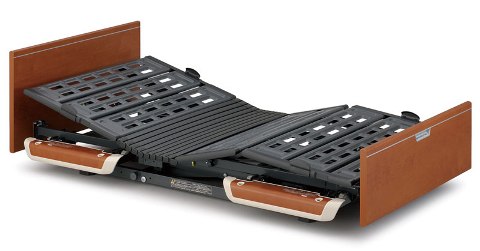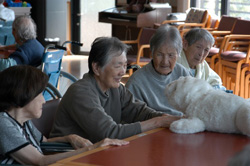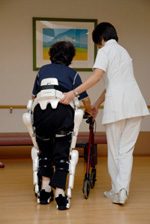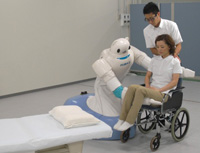Web Japan > Trends in Japan > Tech & Life > High-Tech Nursing Care
High-Tech Nursing Care
For Elderly-Friendly Society

High-tech bed "Rakusho Series KQ-9652" developed by Paramount Bed Co. The bed incorporates a motion control system based on human engineering. © Paramount Bed Co.
Japan has become the world's most aged society, with senior citizens aged 65 and over constituting about 23% of the entire population. One prediction holds that two in every five people will be senior citizens in 2050. Meanwhile, Japan has a public nursing care system which everyone aged 40 and older is supposed to join. The scheme provides a variety of services to elderly people recognized as needing nursing care. These include support for shopping and other livelihood matters and for going to bed, changing sleeping positions and rising in bed, as well as for using nursing care facilities, all available at 10% of costs. High technology is being employed in nursing care in Japan, in such products as automatically rising/reclining beds (based on human engineering) and nursing care robots, to help care receivers live more comfortably. These technologies, which also help reduce caregivers' physical burden, are expected to be an important part of Japan's nursing care system in the near future. The aging of society is not confined to Japan; it is a challenge common throughout advanced countries of the world. Japan's high technologies can be instrumental in shaping a new kind of aged society in the future.

The bed helps the user sit up by balancing movements of the upper and lower parts of the body so that pressure on the chest and belly can be reduced. © Paramount Bed Co.
Enlarge photoAutomatically Controlled Bed
Some people are forced to stay in bed due to old age or illness. It is not uncommon that people stay in bed around the clock, including mealtimes. Bedridden people often suffer from bedsores or worse health conditions unless they constantly change their position in bed. However, getting a person to sit up in bed requires some physical strength on the part of a caregiver.
A Japanese bed-manufacturing company has developed a high-tech bed with a motion control system aimed at solving just that problem. The company analyzed 6,500 combinations of bed movements to find the least painful body positioning in bed based on human engineering. It came up with an ideal bed movement pattern that causes the least uncomfortable body positioning and minimizes the feeling of oppression. The high-tech bed has these factors programmed into a built-in computer. When a person lying in bed pushes the buttons on an LCD remote controller, the bed moves to help the person sit up, automatically balancing the upper and lower parts of the body.
The bed can significantly reduce the pain in the chest and belly inflicted by conventional automatic beds designed to lift the upper half of the body alone. The high-tech bed is capable of lifting the upper body to any angle between 0 and 75 degrees, and the knee portion between 0 and 35 degrees, allowing the user to choose any angle felt most comfortable. The bed not only makes it more comfortable for a person lying in bed to rise, but also significantly reduces the burden of a caregiver.
Robots for Walking and Moving Assistance
Left: "Robot Suit HAL" for Well-being assists the user in walking. Developed by Prof. Yoshiyuki Sankai of the University of Tsukuba. © Prof. Sankai, University of Tsukuba/CYBERDYNE Inc.
Right: The robot helps a person wearing it walk by detecting bioelectric signals sent from the brain to relevant parts of the body and activating power units attached to the robot's joints. © Prof. Sankai, University of Tsukuba/CYBERDYNE Inc.
Moves are afoot to use high technologies more actively in a wider area of nursing care. Japan is developing robots for nursing care, and self-moving support designed to help elderly people walk or move on their own.
One such product is a robot system for walking support, dubbed "Robot Suit HAL" for Well-being developed by Prof. Yoshiyuki Sankai of the University of Tsukuba. HAL stands for Hybrid Assistive Limb®. The “robot suit” comes with a pair of limb frames made of fiber-reinforced plastic. The limb frames cover the outside of a person's limbs, from the waist to both feet.
As a person attempts to move, the brain sends bioelectric signals to the relevant parts of the body. The robot suit detects these biosignals with sensors and activates power units attached to the various joints of the suit, helping the user make leg movements. In short, it substitutes for a person's impaired legs or weakened leg muscles, helping the user conquer walking difficulties.
Left: Robot for Interactive Body Assistance (RIBA), developed by RIKEN-TRI Collaboration Center for Human-Interactive Robot Research. It is a humanoid with the face of an adorable bear. © RIKEN-TRI Collaboration Center for Human-Interactive Robot Research.
Right: The robot uses two arms to lift up a person lying in bed or sitting on a wheelchair, moves and sets him or her down. © RIKEN-TRI Collaboration Center for Human-Interactive Robot Research.
"RIBA" is a nursing care assistance robot developed to move a person from the bed to other places. The newest RIBA II is basically humanoid in appearance, 137 cm tall and 82 cm across, but with the face of an adorable bear. The robot uses its two arms to lift a person from the bed or a wheelchair, and can move and set him or her down wherever necessary. The robot has been developed by putting together the newest control, sensor, information processing and structural design technologies. It can lift a person weighing up to 80 kg.
One of the toughest duties required of caregivers is to lift a person lying in bed and set him or her in a wheelchair. With the robot taking care of that muscle work, caregivers are freed from the tough work.
Seal Robot for Mental Care

Baby seal robot "PARO" developed by AIST. The body is covered with artificial fur pleasant to touch. © AIST
Enlarge photoNot only nursing care assistance and self-support but also mental care is important for elderly people. Communication robots are being developed for mental care. PARO, a seal-shaped robot developed in Japan, is also called a "mental commitment robot" or a therapeutic seal robot, giving joy and comfort to people who play with it.
PARO, modeled after a baby harp seal, measures 57 cm and weighs 2.7 kg. As a person picks it up, caresses it or speaks to it, the robot seal responds as if it were alive, blinking, moving limbs and tilting its head. It even remembers its new name, understands greetings and words of praise, and responds accordingly with a body movement or a trill. Elderly people, devoid of a conversation partner, can communicate with PARO, which appears to be just like a living animal. By caressing its body covered with artificial fur very pleasant to touch, they can release stress, relax and even get cheered up.

The robot moves limbs and tilts its head as it is caressed or spoken to. The robot, which looks as if it were a live animal, gives comfort to elderly people playing with it. © AIST
Enlarge photoPARO, developed by the National Institute of Advanced Industrial Science and Technology (AIST), funded by the Japanese government, is currently serving the mental care needs of elderly people in about 30 countries including European nations and the U.S.
Japan’s high technologies are being put to use one after another in varying areas of nursing care. They are developing a whole new industry in the country and, at the same time, contributing to building a society more accommodating to the needs of aged people.
(September 2012)




